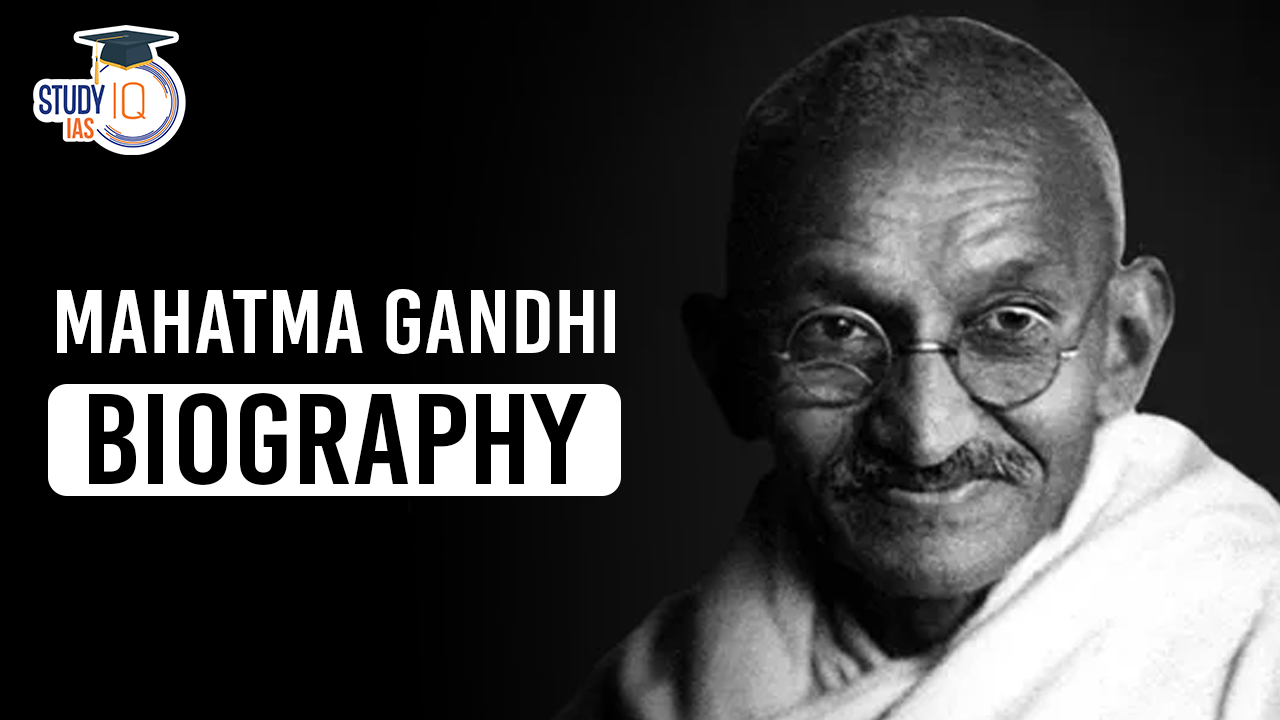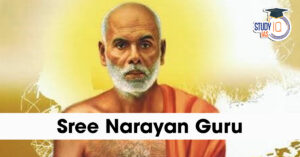Table of Contents
Mahatma Gandhi, known as the “Father of the Nation,” played a pivotal role in India’s struggle for independence from British rule. His philosophy of nonviolent resistance, known as Satyagraha, and his emphasis on civil disobedience transformed the freedom movement and inspired countless others worldwide. This article explores Gandhi’s life, his principles, and his lasting impact on India’s socio-political landscape.
Mahatma Gandhi Biography
Mohandas Karamchand Gandhi, also honored as Mahatma Gandhi was a preeminent figure in India’s struggle for Independence from British rule through his ideology of non-violence. He was a renowned freedom activist and the most influential political leader of India. He was also known as Father of India, (Bapu) and Mahatma (Great Soul). Mahatma Gandhi also worked for India’s poor people and depressed classes. Martin Luther and Nelson Mandela were also influenced by his ideology of truth and non-violence.
Mahatma Gandhi’s Birth Date
Mahatma Gandhi was born on 2nd October in Porbandar, Gujarat. This date is observed as International Day for non-violence and Mahatma Gandhi Jayanti is also celebrated on 2nd October. His father’s name was Karamchand Gandhi who was the dewan of Porbandar and his mother’s name was Putlibai. He was married at an early age his wife’s name was Kastubai Makhanji Kapadia and has 4 sons Harilal, Devdas, Manilal, and Ramdas. Know More about Mahatma Gandhi’s Biography, Ideology, Major Movements, and Books in this Article.
Mahatma Gandhi Education
- Mohandas Karamchand Gandhi received his primary education in Rajkot where his father had relocated as dewan to the ruler Thakur Sahib.
- At the age of 11 years, he went to Alfred High School in Rajkot. Gandhiji at the age of 18, graduated from a high school in Ahmedabad.
- To study law he went to London University to become a barrister. He returned to India in 1891 at the age of 22 after his mother passed away.
Mahatma Gandhi’s Contribution in South Africa
In 1893, Mohandas Karamchand Gandhi travelled to South Africa due to his client case named Dada Abdullah where he witnessed apartheid (racial discrimination against blacks and Indians). After he witnessed such an issue he decided to stay in South Africa to bring the Indian workers together and enable them to fight for their rights.
Moderate Phase of Resistance (1894 -1906): He set up the Natal Indian Congress along with a newspaper named ‘Indian Opinion’ to unite different sections of Indians.
Passive Resistance Phase (1906-1914): In this phase, Gandhiji used the method of Civil Disobedience which he called Satyagraha. In this process, he also set up Tolstoy Farm for the family of satyagrahis. He with his followers was jailed for their resistance.
Eventually, through several phases of negotiations, an agreement was reached, by which the government agreed to accept the major demands of the Indians and promised to treat the issue of Immigration in a lenient manner.
Mahatma Gandhi in India 1915
On the solicitation of Gokhale, conveyed by CF Andrews (Deenbandhu), Gandhiji got back to India to assist with the Indian battle for freedom. The last period of Indian Public development is known as the Gandhian period.
Mahatma Gandhi became the most prominent leader of the Indian National Movement. He employed his principles of nonviolence and Satyagraha against the British. Gandhi made the nationalist movement in India a mass movement.
Mahatma Gandhi soon after his return from South Africa joined the INC (Congress) and was introduced to Indian issues and politics and Gopal Krishna Gokhale became his political Guru.
Mahatma Gandhi’s Early Movements
Gandhiji after returning from Africa in 1915 and joining the Indian National Congress, his political guru was Gopal Krishna Gokhale. In 1916 at Ahmedabad, he established Sabarmati Ashram so that his followers could practice truth and nonviolence.
1. Champaran Satyagraha 1917
Champaran Satyagraha was the first civil disobedience movement organised by Mahatma Gandhi. Rajkumar Shukla asked Gandhiji to look into the problems of the indigo planters in Bihar. The European planter been forcing the farmers to grow Indigo on 3/20 of the total land called the Tinkatiya system against which Gandhiji launched passive resistance or civil disobedience.
Prominent leaders such as Rajendra Prasad, and Anugrah Narayan Sinha stepped forward with Gandhiji to fight for the indigo farmers. Gandhiji was able to convince the Britishers to abolish the system and the peasants were compensated for the illegal dues extracted from them.
2. Kheda Satyagraha 1918
Kheda Satyagraha was the first non-cooperation movement organised by Mahatma Gandhi. Due to the drought of Kheda, Gujarat in 1918, the people of Kheda were unable to pay high taxes levied by the British due to the failure of crops and the plague epidemic.
Peasants were supported by Gandhi who asked them to withhold revenue. During the Kheda Satyagraha, young leaders such as Sardar Vallabhbhai Patel and Indulal Yagnik became followers of Mahatma Gandhi. The government finally agreed to form an agreement with the peasants and hence the taxes were suspended for the years 1919 and 1920 and all confiscated properties were returned.
3. Ahmedabad Mill Strike, 1918
Ahmedabad Mill Strike: Gandhiji did his first hunger strike during this movement. He intervened in the dispute between Mill owners of Ahmedabad and the workers over the issue of discontinuation of the plague bonus. The demand for workers was a rise of 50% in their wages while the employees were willing to concede only a 20% bonus.
Workers under the leadership of Anusuiya Sarabai asked Mahatma Gandhiji for his support, who asked the workers to go on strike without being violent and Gandhiji went on fast until death. Mill owners at last agreed to submit the issue to the tribunal and with the hike of 35% wage the strike was withdrawn.
Mahatma Gandhi in Indian National Movement
1. Khilafat Movement 1919
At the time of World War I, Gandhi sought cooperation from the Muslims in his fight against the British by supporting the Ottoman Empire which had been defeated in the world war. The British passed the Rowlatt Act to block the movement by the Indian nationalists. Mahatma Gandhi called for a nationwide Satyagraha against the act.
It was Rowlatt Satyagraha that gave Gandhiji the recognition of a national leader. Rowlett Satyagraha was against the unjust law passed by the British in the name of the Rowlatt Act. The Jalliawala Bagh Massacre took place on April 13th, 1919 Gandhiji seeing the violence spread called off the Rowlatt Satyagraha on the 18th of April.
2. Non-Cooperation Movement 1920
Mahatma Gandhi advised the leaders of Congress to begin the Non-Cooperation Movement in support of the Khilafat Movement. At the Nagpur congress session in 1920, the non-cooperation program was adopted.
The incidence of Chauri Chaura took place in 1922, which became the reason why Mahatma Gandhi called off the non-cooperation movement. After the end of the non-cooperation movement, Gandhi focused on his social reform work and was not very active in the political sphere.
3. Salt March and Civil Disobedience Movement, 1930
Gandhi announced that he would lead a march to break the salt law as the law gave the state the Monopoly on the manufacturing and sale of salt.
Gandhi along with his 78 followers started his march from his ashram in Sabarmati to the coastal town of Dandi in Gujarat where they broke the salt law of the government by gathering natural salt and boiling seawater to produce salt which also marked the beginning of Civil Disobedience Movement.
4. Gandhi Irwin Pact 1931
Mahatma Gandhi accepted the truce offered by Irwin and called off the civil disobedience movement and accepted to attend the second-round table conference in London as the representative of INC. After returning from London, he relaunched the civil disobedience movement but by 1934 it had lost its momentum.
Read More: Gandhi Irwin Pact
5. Incidences after Civil Disobedience Movement
Communal Award, 1932: The Communal Award was created by British Prime Minister Ramsay MacDonald on 16 August 1932. It was introduced following the Round Table Conference (1930–1922) and expanded the separate electorate to depressed Classes and other minorities. It is also known as the MacDonald Award. The main purpose of the communal award was to maintain a separate electorate for Muslims, Sikhs and Europeans.
Poona Pact, 1932: It was the pact reached between B.R Ambedkar and Gandhiji concerning the communal awards provided for the depressed class but, in the end for the upliftment of the marginalized communities of the Indian society both came on the same understandings.
Mahatma Gandhi Resigned INC, 1934: He did not agree with INC’s positions on various matters but he returned to active politics in the Lucknow Session of Congress (1936) which was presided over by Jawahar Lal Nehru.
Quit India Movement 1942: The outbreak of World War II in 1939 and the last and crucial phase of the national struggle in India came together with the failure of the Cripps Mission in 1942 which gave the immediate reason for the launch of the Quit India movement.
At the Bombay Session of the All-India Congress Committee on 8th August 1942, Gandhiji launched the Quit India movement. Gandhiji demanded British leave India with immediate effect. He called for a mass movement that was followed by non-violence. Most of the major leaders of Congress including Mahatma Gandhi were arrested.
Mahatma Gandhi Ideologies
Mahatma Gandhi developed a set of religious and social ideas initially during his period in South Africa from 1893 to 1914 and later during the freedom struggle movement in India. He developed these ideologies from various sources that inspired him including Bhagavad Geeta, Jainism, Buddhism, Bible and Gopal Krishna Gokhale.
These ideologies have been further developed by followers of Mahatma Gandhi most notably, in India by Vinoba Bhave and Jayaprakash Narayan, outside of India by Martin Luther King Jr., Nelson Mandela, and others. Major Gandhian ideologies are as follows.
| Ideology | Details |
| Truth and Non-Violence | They are the twin principles of Gandhian thoughts. For Gandhiji, the truth is
Nonviolence is an active love, that is, the polar opposite of violence, in every sense. Nonviolence or love can be considered the highest law of humankind. |
| Satyagraha | It is a method of getting our rights through nonviolent action, that is, through self-suffering and penance instead of inflicting injury on others.
It refers to the exercise or practice of the purest soul force against all injustice, oppression, and exploitation. The origin of Satyagraha can be seen in the Upanishads, and also in the teachings of Buddha, Mahavira, and other greats including Tolstoy and Ruskin. |
|
Sarvodaya |
The term Sarvodaya means ‘Progress of All’ or ‘Universal Uplift’.
It was first introduced by Gandhiji as the title of his translation of John Ruskin’s book on political economy, Unto the Last. |
Mahatma Gandhi’s Important Books
Here is a list of some important books written by Mahatma Gandhiji given below:
| Books Written By Mahatma Gandhi | |
| Hind Swarajya (1909) | Mangalaprabhata (1930) |
| Indian Home Rule (1910) | India’s Case for Swaraj (1931) |
| Sermon on the Sea (1924 – the American edition of Hind Swaraj) | Songs from Prison: Translations of Indian Lyrics Made in Jail (1934) |
| Dakshina Africana Satyagrahano Itihasa / Satyagraha in South Africa (1924-25) | The Indian States’ Problem (1941) |
| Satyana Prayogo Athava Atmakatha / An Autobiography: The Story of My Experiments with Truth (1924-25) | Self-restraint v. Self-Indulgence (1947) |
| Gandhi Against Fascism (1944) | From Yeravda Mandir: Ashram Observances (1945) |
| Conquest of Self (1946) | Women and Social Injustice (1947) |
Mahatma Gandhi Slogans
He gave various slogans during his freedom struggle such as,
- Do or Die
- Nonviolence is a weapon of strong
- Be the change that you want to see in the world
- In a gentle way, you can shake the world
Mahatma Gandhi Assassination
Mahatma Gandhi was assassinated on January 30, 1948, by Nathuram Godse, a Hindu nationalist opposed to Gandhi’s principles of nonviolence and religious tolerance. Godse shot Gandhi at Birla House in New Delhi, ending the life of a key leader in India’s independence movement. Gandhi’s death shocked the world, leading to national mourning and reinforcing his legacy of peace and nonviolent resistance, which continues to inspire global movements for justice and human rights.
76th Mahatma Gandhi Death
January 30th commemorates the 76th death anniversary of Mahatma Gandhi, the revered father of the nation, assassinated by Nathuram Godse in 1948. Known as “Bapu,” Gandhi’s pivotal role in India’s freedom movement showcased the power of non-violence. This day, also observed as Martyrs’ Day or Shaheed Diwas, pays homage not only to Gandhi but to all martyrs sacrificing for their country. On that fateful day in 1948, Godse fatally shot Gandhi as he headed to a prayer meeting.
Gandhi’s influence in promoting peace and non-violence during movements like the Salt Satyagraha and Quit India Movement remains significant. The day is marked by nationwide prayers, government officials, and citizens gathering at memorials to honour freedom fighters. Rituals include a two-minute silence to reflect on the sacrifices made by martyrs.
Mahatma Gandhi’s Legacy
Gandhi’s principles of nonviolence and civil disobedience left an indelible mark on global movements for social justice. Leaders like Martin Luther King Jr. and Nelson Mandela drew inspiration from his teachings in their own struggles against oppression. Gandhi’s life and philosophy continue to resonate, reminding us of the power of peaceful resistance in the face of injustice.


 Tansen Biography, Musical Legacy and Mas...
Tansen Biography, Musical Legacy and Mas...
 Sree Narayana Guru (1856–1928), Key Mo...
Sree Narayana Guru (1856–1928), Key Mo...
 Mangal Pandey Biography, History and Rol...
Mangal Pandey Biography, History and Rol...





















